The Bedfordshire Regiment in the Great War

The Battle of Delville Wood; Longueval 27th to 31st July 1916
This account comes almost entirely from the book 1st Bedfordshires Part One; Mons to the Somme by Steven Fuller, pages 174-185, Fighting High Publishing (2011), with some additional information and imagery included that I was unable to build in at the time of publishing
Longueval was a fortified village just 4km north of the objectives set for capture during the opening day of the Battle of the Somme. It formed part of the well sited German second defensive line which Allied planners had expected to capture early in July but as the month drew to a close, it still eluded them. The village had been heavily disputed since 14 July with control swinging wildly back and forth following attack and counter attack. Now came the turn of the 15th Brigade, who were wound up to retake the positions in yet another assault.
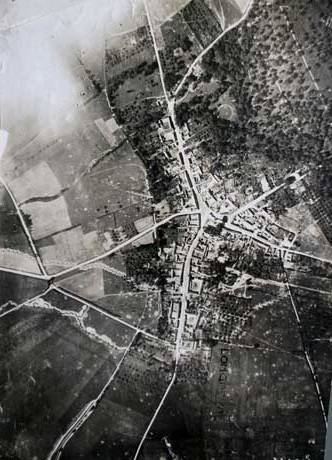 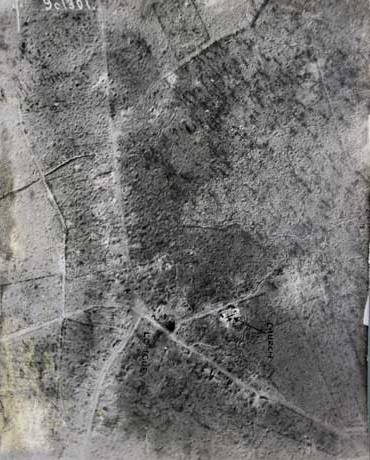 |
Longueval before and after
The battalion's only interruption to an otherwise quiet spell on the Pommier Ridge was late on the 25th when an enormous explosion and firework display erupted from near Mametz, just west of the Bedfordshires in their bivouac area. Initial thoughts of a mine explosion were later quashed when it was learned that the divisional ammunition dump was hit, causing the enormous and impressive explosion. The next day, company officers inspected the ground around Longueval in preparation for the following day's operations whilst the battalion readied itself for what was to come.
To those serving in the area, the German artillery barrage against the southern edges and approaches to Delville Wood and to the west of Longueval was so notorious and intense that it even earned its own name - the 'Longueval Barrage'. During the assault itself, communications between the assaulting battalions and their Brigade H.Q. were completely cut off for twelve hours by the barrage, with almost every man who attempted to find a way through being caught in the inferno.
With preparations complete, late on the 26th July, 23 officers and 807 men from the 1st Bedfordshires set off for battle, leaving the transport and cadre behind. After dropping down into the valley north of Montauban, it became clear that the approaches to their jumping off positions were being smothered with a German shrapnel and gas barrage so a two hour halt was called in the fringe of Caterpillar Valley until a shifting wind created enough of a gap in the gas curtain to enable them to move through. A quick march eastwards along the dark valley floor was not the easiest of tasks and as they approached their destination the 'Longueval Barrage' increased even further, reaching a roaring crescendo. Undaunted and determined to follow orders, the Bedfords pushed on into a series of sunken roads and hastily dug communications trenches, Captain Frederick Parker being hit by shrapnel during the move. The battalion arrived in their positions in the old German second line trench system just south of the village at 3.50 a.m.
At 5.10 a.m. a British bombardment opened on German positions in the village, which lasted for two hours whilst the assaulting battalions shook themselves into shape. Twenty minutes later, operational orders arrived and were filtered down to company level, keeping the men busy with preparations throughout the bombardment.
As per their timetable, A and B Companies left their positions at 7 a.m., advancing north to take up the line being vacated by the 1st Norfolks, who had advanced across No Man's Land towards the German positions inside the village at 7.10, just as the bombardment lifted onto a second, unseen line further north. B Company set up on the west of North Street, which ran north to south through the village, with A Company extending the line to the east. The next expected move was to have been at 8.10 but half an hour later an urgent message was passed back to the Bedfordshires that the Norfolks had been held up by heavy shell fire near the centre of the village and needed immediate support. Lieutenant Colonel Allason took charge of the situation, ordering A and B Companies to advance to the Norfolks, finding them pinned down south of the village centre.
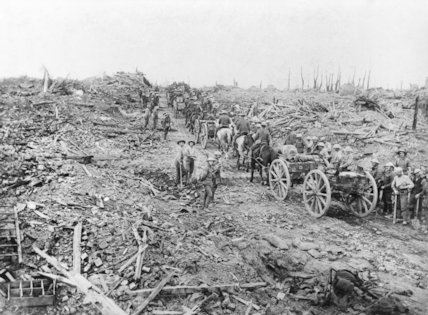
The road into Longueval centre, which was covered by German artillery
It became apparent that the original plans were doomed to failure as the assaulting Norfolks were already too thin on the ground. The Norfolks were initially assigned to take the second objective too, being the centre of the village, but with the arrival of their extra weight of numbers, plans were made by Allason for the two companies of Bedfords to join the Norfolks and take the advance on at 8.10 a.m., with C and D Companies moving into the trenches they would vacate. Once the second line was in their hands, C and D Companies would move through, taking the third and final line at the northern fringes of Longueval until relieved by the 16th Warwicks.
To their east the 2nd Division were advancing towards Delville Wood but the Royal Fusiliers on the Bedfords' eastern flank had been delayed. Despite leaving Allason's advance with an open flank, the decision was taken to continue anyway. Paying close attention to the orchard and open right flank, bayonets were fixed, bombers moved into position behind the leading waves and the mixed Bedford and Norfolk band advanced into an instant storm of shrapnel and machine gun bullets. Moving by short rushes between cover, the grim task of clearing each house by hand to hand fighting began, bombs and bayonets becoming the order of the day.
Amongst the early casualties was Private 16755 Arthur Reed of Letchworth who had only been with the battalion a matter of days after recovering from a wound sustained in January whilst serving in the 8th Bedfordshires. He was hit in the abdomen by shrapnel as they advanced through the village. "My chum, Lance Corporal Arthur Armishaw, at once dragged me to a shell hole and put my field dressing on; then he had to rejoin the platoon and I was left lying in this shell hole for five days. During these five days I lay there in agony … I existed on Horlick's malted milk tablets. Old Fritz sent a lot of gas shells over just where I lay and I got partly buried time after time. All my teeth got loose and I went as yellow as a Chinaman." Arthur was eventually found and made it back home, being discharged in September 1917.
Although progress was being made, the infantry had been unable to keep up with the ambitious timetable. At 8.40 the British barrage lifted onto positions further north as arranged but the Bedfordshires and Norfolks were still bogged down in close quarters fighting, so were unable to follow up. This created a surreal situation with the entire village disappearing from the sight of onlookers further back, being ringed by intense artillery barrages from both sides. Of more interest to those inside the ring of fire were the locally operated trench mortars that rained down their own shells into the village itself, often unsure of where the new front line was from moment to moment. With all this going on around them, the infantry could do no more than choose their moments to carry the fight to the next house, pile of rubble or hidden strongpoint, doing so to the exclusion of events surrounding them.
By the time C Company arrived with A Company at 9 a.m. and D Company moved into the new front lines to the west of North Street, no artillery support was left. The new arrivals fixed their own bayonets as A Company advanced into the western section of the village, clearing each house in its turn as they went. With the section secured, they crossed Princes Street that led east into Delville Wood, their eyes on two strong points that had been holding the Norfolks up. To the east of the village and just outside the wood stood a heavily fortified redoubt which the company took at the point of the bayonet, capturing around 100 prisoners in the process. Whilst the position was being consolidated, Lieutenant Arthur Fyson and his shrunken platoon turned their attentions to a strongly held house 150 yards to the west which was stopping any movement around the centre of the village. They assaulted the garrison with such ferocity that the surviving 32 defenders surrendered, bewildered at the determination of Fyson's small, outnumbered band. Fyson would be mentioned in the Commander-in-Chief's despatches for this feat of arms and come through the assault without a scratch.
The advance was temporarily held up by a stubborn German machine gun post in the centre of the village, sited to cover movement in every direction. That position eventually fell after a series of carefully planned rushes and individuals stalking their way forward to draw the enemy fire, enabling Norfolk bombers to force their way in and overwhelm the defenders. The same fate befell the supporting posts covering it and in a curious twist, prisoners captured revealed themselves to be from the German 5th Division.
Meanwhile, two platoons from A Company had been busily working their way north, along the eastern edge of North Street, having completely bypassed the machine gun nest whilst it was being engaged at close quarters. With Delville Wood to their east and the largely German held side of North Street to their west, they had pressed on until reaching the Flers Road, running north-east from the village. Here they met with a group of Royal Fusiliers and the small band collectively started consolidating their lines, waiting for reinforcements to show up on either flank. Once the Norfolks took over the area north of Princes Street, the rest of A Company moved north to support their comrades, setting up a defensive line to the east of North Street. Facing the German defenders on the opposite side of the road, they providing supporting fire as the Norfolks carried their bayonets through the line of rubble running north from the centre of the village.
Once the centre of the village had been consolidated, B Company tried to push on but German machine guns in Duke Street to the north-west stopped any advance into the countryside so they consolidated the line and held the west half of Longueval with D Company in support. The Norfolks held the centre of the village whilst C Company moved to take over the south-eastern section of Longueval.
The forward sections of A and B Companies set up defensive perimeters facing north and west, lining the ruined houses. Pockets of German resistance were encountered as the day went on, more Germans appearing from their shelters in well concealed cellars and dugouts, often behind the front line of troops. Nevertheless, the British bayonets and bombs gradually overwhelmed the defenders until the entire village had fallen, an objective that had been fought hard for since the 15th July.
Communications were now non existent, with both the Norfolk H.Q. and Bedford H.Q. being cut off from anyone outside of the village, as well as one another. Any attempts to lay telephone cables were almost immediately stopped, the signallers being killed or the cables being cut. Runners were assigned the hazardous task of carrying messages through the curtain of explosives and shrapnel as even the brigade's carrier pigeons had all been killed by the afternoon.
Stokes mortars and heavy artillery had been called for to neutralise the German machine gun post on Duke Street, but neither arrived, so the Bedfordshires and Norfolks remained pinned in the village. Fortunately, some cover had been prepared when a German hurricane bombardment fell onto B and D Company's positions late that morning but Captain Barnett quickly understood that the heavy shelling and over crowded trenches were causing serious problems. He quickly moved most of D Company back to the German second line, where they sheltered from the continuous bombardment. The Officer's Mess cook, Private Ashby, was amongst those rushed back to the old line further back, which was being pounded into oblivion. He remarked "There was no room in the dugout, it was full of wounded, so I just waited for death in the open for five long hours." However, by the end of the afternoon B Company had lost two officers and 54 men of the five officers and 166 men they started the day with whilst D Company suffered badly in the bombardment, finally losing two officers from five and 106 of the 176 men who had marched in from the south that morning.
On the open eastern flank men found themselves under fire from defensive posts in Delville Wood who were not under pressure from their front, so looked for targets in the village. Corporal 10145 Thomas Harris of Luton had become the senior officer in his immediate vicinity and decided that enough men had been wounded or pinned down by a particularly troublesome German machine gun post. As a result of his actions, he would be awarded the Distinguished Conduct Medal, with the citation telling of how "He attacked an enemy post in a wood single-handed, and killed five of the enemy. He then fetched up supports and 11 other enemy surrendered. He was wounded."
The 2nd Division had appeared in force that afternoon on the vulnerable eastern flank and secured Delville Wood, which had been the scene of some horrific fighting in the previous week and had earned the inevitable nickname "Devil's Wood". So, with the line intact and the survivors consolidating their gains with absolute urgency, lookouts were posted to warn of the imminent counter attack. It became clear that, although the final objective lay around 250 metres to their north, further advances were doomed to failure as several entrenched and heavily wired machine gun posts were spotted, looking down on them from the ridge.
That evening the expected German counter attack came. It was as determined and ferocious as ever but was repulsed with heavy enough losses to keep the smouldering remains of Longueval in British hands. When it seemed that the counter attacks had petered off for the night, it became clear that the defensive line was far from ideal. A thin outpost line was left in place, with the bulk of those who had survived from each company being withdrawn to a more tenable line amongst the rubble.
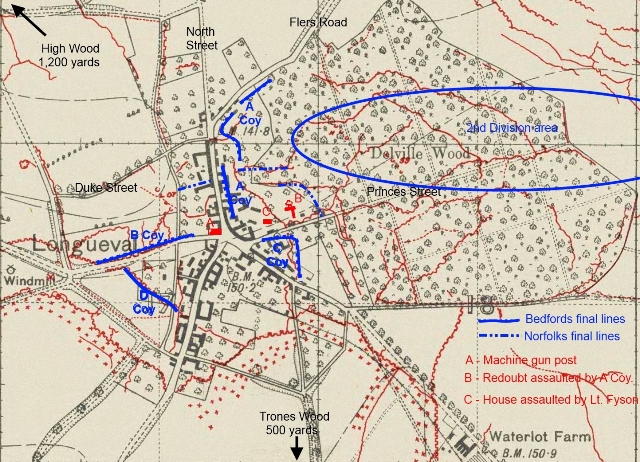
27th July 1916; the final brigade line
9 officers and 303 men were lost during the battalion's assault against Longueval, with 14 officers and 504 men being relieved at 6 a.m. the following morning, when fresh troops arrived to take over. Four officers were killed, being the 23 year old Captain Henry Patrick Claude Burton, 27 year old Second Lieutenant Alfred Charles Hayhoe, 28 year old Second Lieutenant Archibald Clare Holland and the 20 year old Second Lieutenant Norman Douglas Wemyss.
Amongst the wounded officers were Lieutenant Ernest Rex who had been with the battalion for almost a year and had also been wounded in April; Lieutenant Frederick Illingworth who would recover and return to the battalion in time for the Arras offensives the following April; Lieutenant Harry Willans, whose war had already been adventurous having fought in numerous engagements and in several units since his arrival on the front in 1914; Second Lieutenant Charles James Hunter, who had previously recovered from a wound from the 2nd Bedfordshires whilst at Loos the previous year, and who would die from pneumonia 7 days before the armistice in 1918.
Privates 18787 Arthur Boness and 18484 George Boness, cousins from Biggleswade, were amongst the long list of those killed at Longueval. George had been amongst a group buried by a shell during their advance and although dug out alive, he died half an hour later from blood loss as an artery had been severed in the explosion. Arthur's exact fate was unknown as no-one was left to recount the story and the cousins' names sit side by side on the Thiepval Memorial to the missing.
The Boness cousins on the Thiepval Memorial to the missing
Whilst reorganising in their bivouacs back on the Pommier Redoubt the next day, the following message was relayed to the survivors; "15th Infy. Bde. 1st Bedfords. The Brigadier-General Commanding wishes to express to all ranks of the Brigade his great admiration at the magnificent manner in which they captured the Village of LONGUEVAL yesterday. To the 1st NORFOLK Regiment and the 1st BEDFORDSHIRE Regiment and some of the 16th ROYAL WARWICKSHIRE Regiment, who were able to get into the enemy with the bayonet, he offers his heartiest congratulations. He knows it is what they have been waiting and wishing for many months. The 1st CHESHIRE Regiment made a most gallant and determined effort to reach their objective and failed through no fault of their own. The way in which the Troops behaved under the subsequent heavy bombardment was worthy of the best traditions of the British Army. The Brigade captured 4 Officers and 159 other ranks 28/7/1916."
Following a quiet two days recovering and refitting, orders arrived at 6 p.m. on the 30th July for the battalion to move urgently back to Longueval. Within an hour the battalion were organised and on their way, arriving in the village 45 minutes later to reinforce the 13th Brigade, who had been heavily engaged whilst trying to capture the orchards north of the village.
The day had seen a localised British offensive launched which included their sister battalion, the 2nd, assaulting Maltz Horn Farm just 3km south of Longueval. However, matters in their own vicinity were more pressing as reports had been received that the 2nd Kings Own Scottish Borders had been heavily counter attacked and were retiring from their lines just north of the village, astride North Street. The Bedfords were rushed in to regain and hold the line regardless of whatever was causing the retirement. A and C Companies quickly moved north, although the Scottish guides were unable to find their companies in the dark so the Bedfords set up a line north of the village and sent their own patrols out to establish what had happened. B and D Companies set up a defensive line amongst the rubble west of North Street, facing west. The intention was to retire the Scots at dawn, leaving the Bedfords in place to continue the defence but their whereabouts was unclear.
A confused night followed. In the darkness parties of Scots Borders were discovered but no fixed line was apparent as their assault had been brought to a bloody halt. In response to the uncertainty the Bedfordshires established their own firm line of resistance in readiness for further counter attacks. Just before midnight a message arrived instructing bombers from the Borders to move into the sunken road heading north-east towards Flers, as the Gordon Highlanders were in position there and a continuous line needed to be established. Within twenty minutes of them moving out an intense German bombardment fell on the village, causing the defenders to seek what shelter they could in the low piles of rubble that were once houses.
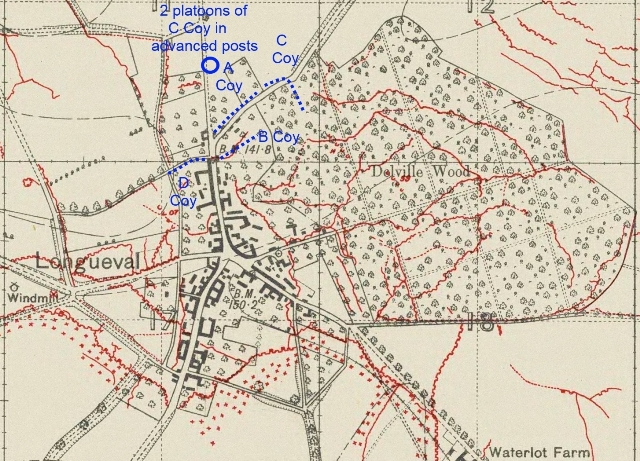
Situation overnight 30th July / 1st August 1916
By 2.30 a.m. on the 31st all companies reported heavy casualties from the barrage but the lines were intact, with contact having been made with the division to the east. Despite the mist, smoke, darkness and four hours of intense bombardment, by 6.25 a.m. a continuous battalion line was formed, running from 100 metres west of North Street on the northern boundary of Longueval, along the Flers Road to the sunken section of road some 200 metres towards Flers. C Company on the eastern flank refused their flank as the situation in Delville Wood was still unclear and 2 platoons were moved 200 metres north of the main line to try to make contact with the 2nd Division. Any uncertainty surrounding the wood was soon cleared up once several German patrols stumbled into the Bedfordshires lines in the pitch black night. Each successive patrol was broken up by bursts of rifle and machine gun fire, the dark wood coming alive with fire from all directions with each fresh encounter.
Along the northern edge of C Company's sector a patrol moved north towards the German lines, intent on learning just who held the positions. A heavy burst of fire made it clear the occupants were unfriendly so the patrol spent the next few hours playing cat and mouse with the enemy gunners as they slowly made their way back to their own lines.
With daybreak, patrolling ceased and all day German snipers and artillery observers plagued the Bedford's lines. A sniping duel developed, each side goading their counter parts into revealing themselves until at 6 p.m. the first phase of relief arrived. The Scots were relieved immediately and the forward sections from the Bedfords were also moved back to the centre of the village. Around 10.30 p.m. the Cheshires arrived to relieve the entire battalion and the companies withdrew independently to their bivouacs in the Pommier Redoubt once relieved.
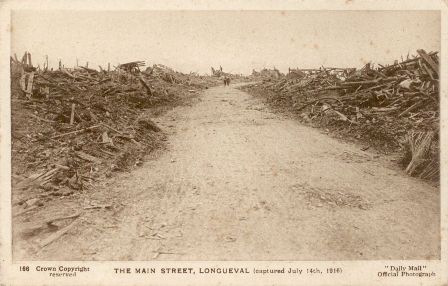
The main street after the fighting had passed
By daylight on the 1st August Longueval had claimed another 188 men, including two officers killed and six more wounded.
23 year old Second Lieutenant David Newbold Gaussen and 20 year old Second Lieutenant Arthur Norris Marshall were both killed in the darkness.
Those wounded were:
Captain William Nottidge who was mentioned in despatches for his behaviour at Longueval in January 1917, but having been knocked unconscious and buried by the same shell he would be amongst the numerous soldiers who spent many months recovering from shell shock and what was recorded as "strain from prolonged service, including terrifying dreams" before returning to the 4th Bedfordshires early the following year
Lieutenant Sidney Gerald Mulligan who would recover from wounds and shell shock in time for the Arras offensives in April 1917, when he would fall in the 4th Bedfordshires' assault against Gavrelle
Lieutenant Leonard Johnstone Jones was wounded for a second time, the first having been on Hill 60 in May 1915, and who would die suddenly of heart failure attributed to his war service in June 1921, aged just 25
Lieutenant Ronald Johnstone Haye who had been with the battalion since April, was wounded by shrapnel in his right shoudler and who would suffer from severe shell shock for many months before joining the 3rd Bedfordshires although he was never deemed fit for active service again
Lieutenant Charles Percival Mattey was wounded in the right forearm by shrapnel, was shell shocked, and who would be killed a few months later while serving in the 8th Battalion
Lieutenant Oscar Dunsford Roeber, whose brother David was killed in the 7th Bedfordshires two weeks later. The Somme had caused many more cases of shell shock within the battalion than previously seen and the 21 year old Oscar Roeber was yet another. Having been buried in the intense shelling he was returned to England suffering from shell shock where he would undergo many months of medical treatment for the nervousness, headaches, palpitations, sleeplessness, violent dreams and a bad stammer. 18 months later he was fit for general service again and transferred into the Royal Flying Corps.
Of the 15 officers' service records which survived from those who came through Longueval alive, all bar 2 include medical board reports for treatment for shell shock - many severe as the examples above. How many of the Other Ranks were left in similar shape is impossible to tell.
Two brothers from Yelling would also soon be receiving some dreadful news telling how each of them had lost a son at Longueval. Privates 18042 Albert Currington and 19384 William Currington both fell during the battle and as if that was not a high enough price to pay, a further three from the remaining four cousins would also be wounded before the war was over.
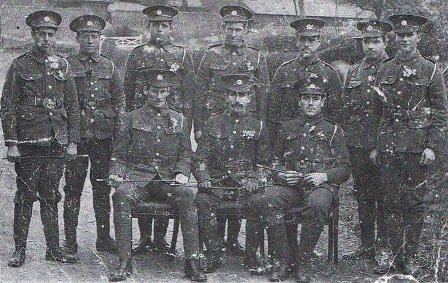
The extended Currington family from Yelling and surrounding areas, including William (front row, left side) and Albert (front row, right side)
After three gruelling days assaulting and holding the heavily fortified and defended village, just over 300 men were left, including eight officers.
The casualty list was certainly long but amongst the sad news was the occasional tale of good luck and survival against the odds. Of those reported missing from the battalion, a tired, officer-less group of men comprised of the remnants of several platoons arrived back with the battalion days later, having been left holding the orchard and waiting for either relief or orders. Ambling back towards the battalion perimeter in tattered rags vaguely resembling uniforms and holding battered rifles, the bedraggled, filthy band were soon smiling from ear to ear once greeted with the usual torrent of banter from their chums.
Some days after the division had been relieved, a filthy, exhausted band of Scots Borders arrived in the British lines, having been isolated in the final objective of their attack on the 30th. They had remained in place, fending off one attack after another but had finally exhausted their water and ammunition supplies, so had retired back to their own lines.
Bob Pigg of Royston was still in D Company when the battalion advanced on Longueval. Bob's cousin, Albert came through without a scratch and although Bob himself had come through the war remarkably unscathed so far, German gunners finally found him amongst the rubble. His local paper reported how "he was buried twice and blown right out of the trench by a shell explosion". Bob spent a few weeks recovering at a convalescent camp in Boulogne but was soon back with his company, carrying on as if nothing had happened.
Private 8059 William (Bob) Pigg
Thirteen year veteran Private 8081 George Gazeley from Westoning had joined the battalion as a 19 year old groom and was one of the many wounded, being hit in the right buttock during the fighting. Having been out with the battalion since August 1914, he typified the service of many such men as this was not his first wound and would not be his last. Hit in the chest in November 1914, he returned and became a Sergeant in April 1915. George was wounded again in the left arm in May 1915, during the final few days of the defence of Hill 60 and was on the long casualty list for a third time after Longueval. George's leadership during the fighting would earn him the Military Medal and four months in Blighty recovering but his time on the front lines with the battalion was not over yet as he would return again in the New Year.
Another veteran of Mons to win the Military Medal whilst being wounded at Longueval was Sergeant 10190 Oswald Gentle from Baldock who had served with the battalion since January 1913. George had been on the front constantly throughout the war and had certainly earned the respect of his comrades, his local papers reporting that he had not lived up to his name. Sergeant Gentle was hit in the foot by shrapnel, although he was back with the battalion before the end of the year.
Veterans of the fighting in Longueval recall it as being memorable for being the most intense concentration of shell fire men from the 5th Division experienced during the war. Several letters home referred to highly experienced men "going mad" from the shelling once their already frayed nerves were subjected to the unending blitz.
One such example was the cool headed Sergeant 7623 Sidney Spott Chamberlain. Sidney had seen thirteen years in the regiment, had served through Mons and all of the early battles, had recovered from having been gassed on Hill 60 and had adapted to everything thrown at him by both the enemy and nature. In July 1916 he had become 'Time Expired' and had the option to finish his service with the colours but chose to remain with the battalion. Sergeant Chamberlain had survived the intensity of the fighting and barrage at Longueval but by the time they returned to hold the village, shell shock took hold of his nervous system early in August. Despite his remonstrations, he was sent back from the lines to recover and would rejoin his chums some weeks later.
Sergeant, later WOII 7623 Sidney Chamberlain
Site built by Steven Fuller, 2003 to 2023